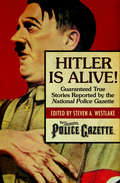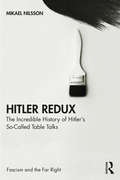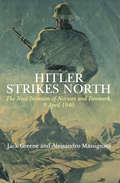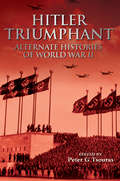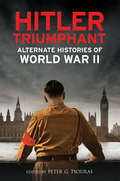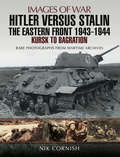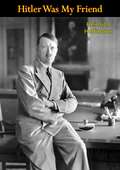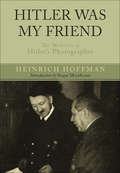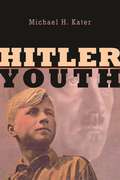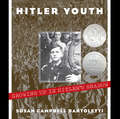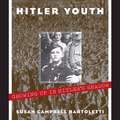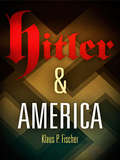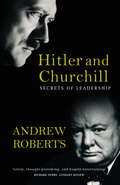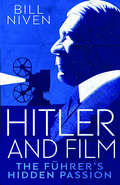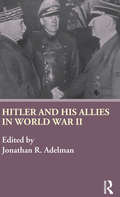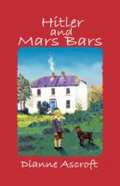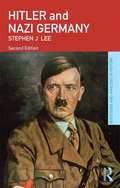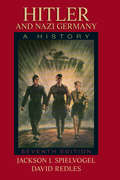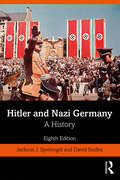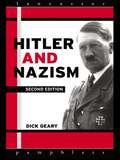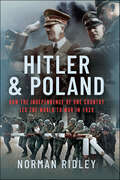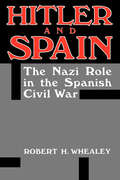- Table View
- List View
Hitler Is Alive!: Guaranteed True Stories Reported by the National Police Gazette (Police Gazette #1)
by Steven A. WestlakeActual articles from the notorious sensationalist journal that was a forerunner to the scandal sheets and tabloids of today: &“Ridiculous alt-history fun&” (Booklist). As the Allied armies closed in on Berlin, the Nazi high command scrambled to escape their shattered city. On May 1, 1945, reports went out that Adolf Hitler and his mistress, Eva Braun, committed suicide in an underground bunker—but their bodies were never found. In this landmark exposé by the legendary National Police Gazette, the truth is finally told. As peace fell across Europe, two U-Boats made mad dashes for Argentina, remaining underwater for weeks at a time to evade detection. In their incredible journeys lies the shocking secret of how the greatest mass murderer in history escaped punishment for his crimes. In the aftermath of World War II, the Police Gazette ruthlessly investigated any rumor of Hitler&’s survival in South America. Hitler Is Alive! is a true epic of twentieth-century sensationalism.
Hitler Redux: The Incredible History of Hitler’s So-Called Table Talks (Routledge Studies in Fascism and the Far Right)
by Mikael NilssonAfter Hitler's death, several posthumous books were published which purported to be the verbatim words of the Nazi leader – two of the most important of these documents were Hitler's Table Talk and The Testament of Adolf Hitler. This ground-breaking book provides the first in-depth analysis and critical study of Hitler’s so-called table talks and their history, provenance, translation, reception, and usage. Based on research in public and private archives in four countries, the book shows when, why, where, how, by and for whom the table talks were written, how reliable the texts are, and how historians should approach and use them. It reveals the crucial role of the mysterious Swiss Nazi Francois Genoud, as well as some very poor judgement from several famous historians in giving these dubious sources more credibility than they deserved. The book sets the record straight regarding the nature of these volumes as historical sources – proving inter alia The Testament to be a clever forgery – and aims to establish a new consensus on their meaning and impact on historical research into Hitler and the Third Reich. This path-breaking historical investigation will be of considerable interest to all researchers and historians of the Nazi era.
Hitler Strikes North: The Nazi Invasion of Norway and Denmark, 9 April 1940
by Jack Greene Alessandro MassignaniA detailed account of Germany&’s groundbreaking Operation Weserübung, the first three dimensional—land, sea, air—strategic invasion in history. The German invasion of Denmark and Norway in April 1940 brought a sudden and shocking end to the &“Phoney War&” in the West. In a single day, multiple seaborne and airborne landings established German forces ashore in Norway, overwhelming the unprepared Norwegian forces and catching the Allied Powers completely by surprise. Their belated response was ill-thought-out and badly organized, and by June 9 all resistance had formally ended. The strategic importance of Scandinavian iron ore, shipped through the port of Narvik to Germany, was the main cause of the campaign. The authors show how Allied attempts to interdict these supplies provoked German plans to secure them, and also how political developments in the inter-war years resulted in both Denmark and Norway being unable to deter threats to their neutrality despite having done so successfully in the First World War. The German attack was their first &“joint&” air, sea, and land operation, making large-scale use of air-landing and parachute forces, and the Luftwaffe&’s control of the air throughout the campaign would prove decisive. Although costly, particularly for the Kriegsmarine, it was a triumph of good planning, improvisation and aggressive, determined action by the troops on the ground. Making full use of Norwegian, Danish, and German sources, this book is a full and fascinating account of this highly significant campaign and its aftermath both for the course of the Second World War and the post-war history of the two countries conquered with such unprecedented speed.
Hitler Triumphant: Alternate Decisions of World War II
by Peter G. TsourasEdited by the author of Disaster at D-Day, a collection of alternative histories that force readers to consider what could happen if the Nazis won World War II. Based on a series of fascinating &“what ifs&” posed by leading military historians, this compelling new alternate history reconstructs the moments during the Second World War that could conceivably have altered the entire course of the war and led to a German victory. Based on real battles, actions, and characters, each scenario has been carefully constructed to reveal how at points of decision a different choice or minor incident could have set in motion an entirely new train of events altering history forever. Scenarios in this volume include the fall of Malta in 1942 and the likely consequences and the possibility of Halifax making peace with Hitler. Contributors include John Prados, editor of The White House Tapes: Eavesdropping on the President; David Isby, editor of Fighting the Invasion and The Luftwaffe Fighter Force; and Nigel Jones, author of The War Walk and Rupert Brooke: Life, Death and Myth.Praise for Hitler Triumphant&“An entertaining work of counter-factual history, with some thought-provoking material on the overall course of the war.&” —History of War&“The analysis of battle strategy and military might makes for a top pick for military readers seeking more than fantasy speculation.&” —Midwest Book Review
Hitler Triumphant: Alternate Histories of World War II
by Peter G. TsourasEdited by the author of Disaster at D-Day, a collection of alternative histories that force readers to consider what could happen if the Nazis won World War II.What if Winston Churchill's plane had been shot down and Halifax had become Prime Minister? Or what if Goering had taken power after a successful assassination of Hitler? Or what if Italy had not joined the Third Reich and the Axis?Inspired by a series of hypothetical questions posed by leading military historians, this compelling collection of alternate histories rewrites moments in World War II that could conceivably have altered the entire course of the war and led to a German victory.Based on real battles, actions, and characters, each scenario has been carefully constructed to reveal how different decisions or minor incidents could have set in motion an entirely new chain of events, altering history forever. Other scenarios in this volume include the fall of Malta in 1942, a successful Stalingrad breakout, and a disastrous attempt to open a second front on the Cherbourg peninsula in 1943.Contributors include John Prados, editor of The White House Tapes: Eavesdropping on the President; David Isby, editor of Fighting the Invasion and The Luftwaffe Fighter Force; and Nigel Jones, author of The War Walk and Rupert Brooke, Life, Death and Myth.Praise for Hitler Triumphant“An entertaining work of counter-factual history, with some thought-provoking material on the overall course of the war.” —History of War“The analysis of battle strategy and military might makes for a top pick for military readers seeking more than fantasy speculation.” —Midwest Book Review
Hitler Triumphant: Alternate Histories of World War II
by Peter G. TsourasEdited by the author of Disaster at D-Day, a collection of alternative histories that force readers to consider what could happen if the Nazis won World War II.What if Winston Churchill's plane had been shot down and Halifax had become Prime Minister? Or what if Goering had taken power after a successful assassination of Hitler? Or what if Italy had not joined the Third Reich and the Axis?Inspired by a series of hypothetical questions posed by leading military historians, this compelling collection of alternate histories rewrites moments in World War II that could conceivably have altered the entire course of the war and led to a German victory.Based on real battles, actions, and characters, each scenario has been carefully constructed to reveal how different decisions or minor incidents could have set in motion an entirely new chain of events, altering history forever. Other scenarios in this volume include the fall of Malta in 1942, a successful Stalingrad breakout, and a disastrous attempt to open a second front on the Cherbourg peninsula in 1943.Contributors include John Prados, editor of The White House Tapes: Eavesdropping on the President; David Isby, editor of Fighting the Invasion and The Luftwaffe Fighter Force; and Nigel Jones, author of The War Walk and Rupert Brooke, Life, Death and Myth.Praise for Hitler Triumphant“An entertaining work of counter-factual history, with some thought-provoking material on the overall course of the war.” —History of War“The analysis of battle strategy and military might makes for a top pick for military readers seeking more than fantasy speculation.” —Midwest Book Review
Hitler Versus Stalin: Kursk to Bagration (Images of War)
by Nik CornishThe third volume in Nik Cornishs photographic history of the Second World War on the Eastern Front records in vivid visual detail the sequence of Red Army offensives that pushed the Wehrmacht back across Russia after the failure of Operation Citadel, the German attack at Kursk. Previously unpublished images show the epic scale of the build-up to the Kursk battle and the enormous cost in terms of lives and material of the battle itself. They also show that the military initiative was now firmly in Soviet hands, for the balance of power on the Eastern Front had shifted and the Germans were on the defensive and in retreat. Subsequent chapters chronicle the hard-fought and bloody German withdrawal across western Russia and the Ukraine, recording the Red Armys liberation of occupied Soviet territory, the recovery of key cities like Orel, Kharkov and Kiev, the raising of the siege of Leningrad and the advance to the borders of the Baltic states. Not only do the photographs track the sequence of events on the ground, they also show the equipment and weapons used by both sides, the living conditions experienced by the troops, the actions of the Soviet partisans, the fight against the Finns in the north, the massive logistical organization behind the front lines, and the devastation the war left in its wake.
Hitler Victorious
by Gregory Benford Martin GreenbergEleven Stories of the German Victorie in World War II.
Hitler Was My Friend: The Memoirs Of Hitler's Photographer
by Heinrich Hoffmann Lt.-Col. R. H. StevensHeinrich Hoffmann was the photographer to kings, princes, and the glitterati of the first half of the 20th Century. His archive of images ran into the millions and he grew to be rich and moderately famous. An assistant in London to Emil Otto Hoppé, the undisputed leader of pictorial portraiture in Europe at the time, Hoffmann returned to Germany, progressed through the tumult of WWI into the chaos of the Weimar, and there he came into contact with an idealist with a growing following—Adolf Hitler.As official ‘court’ photographer, Heinrich Hoffmann played a critical role in the painstaking cultivation of Hitler’s public image and the glorification of the Third Reich. However, his influence stretched far beyond the realm of propaganda: not only was he present during many of the key moments in the history of the Third Reich, he was also a close, personal friend of the Führer, with exclusive and intimate access to Hitler’s inner circle and to the man himself. It was Hoffmann who introduced Hitler to Eva Braun, his studio assistant. It was also Hoffmann with whom Hitler was on a trip from Munich to Hamburg when the Führer received word that his beloved niece, Geli Raubal had committed suicide.Hoffmann took over two million photographs of Hitler and published several books, including The Hitler Nobody Knows (1933). At the end of the war, Hoffmann was arrested by the U.S. military, who seized his photographic archive, and was sentenced to imprisonment for Nazi profiteering. These memoirs were first published in English in 1955, four years after his release from prison, and represent a crucial eyewitness source for the historian and general reader alike.
Hitler Was My Friend: The Memoirs of Hitler’s Photographer
by Heinrich HoffmannHeinrich Hoffman was a key part in the making of the Hitler legend, the photographer who carefully crafted the image of the Fhrer as a godlike figure. Hoffmann published his first book of photographs in 1919, following his work as an official photographer for the German army. In 1920 he joined the Nazi Party, and his association with Hitler began. He became Hitler's official photographer and traveled with him extensively. He took over two million photographs of Hitler, and they were distributed widely, including on postage stamps, an enterprise that proved very profitable for both men. Hoffmann published several books on Hitler in the 1930s, including The Hitler Nobody Knows (1933). Hoffmann and Hitler were very close, and he acted not only as a personal confidante—his memoirs include rare details of the Fhrer—but also as a matchmaker it is Hoffmann who introduced Eva Braun, his studio assistant, to Hitler.At the end of the war, Hoffmann was arrested by the US military, who also seized his photographic archive, and was sentenced to imprisonment for Nazi profiteering. This edition of a classic book includes photographs by Hoffmann and a new introduction by Roger Moorhouse.
Hitler Youth
by Michael H. KaterIn modern times, the recruitment of children into a political organization and ideology reached its boldest embodiment in the Hitler Youth, founded in 1933 soon after the Nazi Party assumed power in Germany. Determining that by age ten children’s minds could be turned from play to politics, the regime inducted nearly all German juveniles between the ages of ten and eighteen into its state-run organization. The result was a potent tool for bending young minds and hearts to the will of Adolf Hitler. Baldur von Schirach headed a strict chain of command whose goal was to shift the adolescents’ sense of obedience from home and school to the racially defined Volk and the Third Reich. Luring boys and girls into Hitler Youth ranks by offering them status, uniforms, and weekend hikes, the Nazis turned campgrounds into premilitary training sites, air guns into machine guns, sing-alongs into marching drills, instruction into indoctrination, and children into Nazis. A few resisted for personal or political reasons, but the overwhelming majority enlisted. Drawing on original reports, letters, diaries, and memoirs, Michael H. Kater traces the history of the Hitler Youth, examining the means, degree, and impact of conversion, and the subsequent fate of young recruits. Millions of Hitler Youth joined the armed forces; thousands gleefully participated in the subjugation of foreign peoples and the obliteration of “racial aliens.” Although young, they committed crimes against humanity for which they cannot escape judgment. Their story stands as a harsh reminder of the moral bankruptcy of regimes that make children complicit in crimes of the state.
Hitler Youth (Scholastic Focus): Growing Up in Hitler's Shadow
by Susan Campbell BartolettiRobert F. Sibert Award-winner Susan Campbell Bartoletti explores the riveting and often chilling story of Germany's powerful Hitler Youth groups.In her first full-length nonfiction title since winning the Robert F. Sibert Award, Susan Campbell Bartoletti explores the riveting and often chilling story of Germany's powerful Hitler Youth groups."I begin with the young. We older ones are used up . . . But my magnificent youngsters! Look at these men and boys! What material! With them, I can create a new world." --Adolf Hitler, Nuremberg 1933 By the time Hitler became Chancellor of Germany in 1933, 3.5 million children belonged to the Hitler Youth. It would become the largest youth group in history. Susan Campbell Bartoletti explores how Hitler gained the loyalty, trust, and passion of so many of Germany's young people. Her research includes telling interviews with surviving Hitler Youth members.
Hitler Youth: Growing Up in Hitler's Shadow
by Susan Campbell BartolettiIn her first full-length nonfiction title since winning the Robert F. Sibert Award, Susan Campbell Bartoletti explores the riveting and often chilling story of Germany's powerful Hitler Youth groups.<P><P> "I begin with the young. We older ones are used up... But my magnificent youngsters! Look at these men and boys! What material! With them, I can create a new world." --Adolf Hitler, Nuremberg 1933<P> By the time Hitler became Chancellor of Germany in 1933, 3.5 million children belonged to the Hitler Youth. It would become the largest youth group in history. Susan Campbell Bartoletti explores how Hitler gained the loyalty, trust, and passion of so many of Germany's young people. Her research includes telling interviews with surviving Hitler Youth members.<P> Newbery Medal Honor book and Sibert Honor book
Hitler and America
by Klaus P. FischerIn February 1942, barely two months after he had declared war on the United States, Adolf Hitler praised America's great industrial achievements and admitted that Germany would need some time to catch up. The Americans, he said, had shown the way in developing the most efficient methods of production--especially in iron and coal, which formed the basis of modern industrial civilization. He also touted America's superiority in the field of transportation, particularly the automobile. He loved automobiles and saw in Henry Ford a great hero of the industrial age. Hitler's personal train was even code-named "Amerika."In Hitler and America, historian Klaus P. Fischer seeks to understand more deeply how Hitler viewed America, the nation that was central to Germany's defeat. He reveals Hitler's split-minded image of America: America and Amerika. Hitler would loudly call the United States a feeble country while at the same time referring to it as an industrial colossus worthy of imitation. Or he would belittle America in the vilest terms while at the same time looking at the latest photos from the United States, watching American films, and amusing himself with Mickey Mouse cartoons. America was a place that Hitler admired--for the can-do spirit of the American people, which he attributed to their Nordic blood--and envied--for its enormous territorial size, abundant resources, and political power. Amerika, however, was to Hitler a mongrel nation, grown too rich too soon and governed by a capitalist elite with strong ties to the Jews.Across the Atlantic, President Franklin Delano Roosevelt had his own, far more realistically grounded views of Hitler. Fischer contrasts these with the misconceptions and misunderstandings that caused Hitler, in the end, to see only Amerika, not America, and led to his defeat.
Hitler and Churchill: Secrets of Leadership
by Andrew Roberts'His book is timely and a triumph. Roberts manages to convey all the reader needs to know about two men to whom battalions of biographies have been devoted' EVENING STANDARDAdolf Hitler and Winston Churchill were two totally opposite leaders - both in what they stood for and in the way in which they seemed to lead. Award-winning historian Andrew Roberts examines their different styles of leadership and draws parallels with rulers from other eras. He also looks at the way Hitler and Churchill estimated each other as leaders, and how it affected the outcome of the war. In a world that is as dependent on leadership as any earlier age, HITLER AND CHURCHILL asks searching questions about our need to be led. In doing so, Andrew Roberts forces us to re-examine the way that we look at those who take decisions for us.
Hitler and Churchill: Secrets of Leadership
by Andrew Roberts'His book is timely and a triumph. Roberts manages to convey all the reader needs to know about two men to whom battalions of biographies have been devoted' EVENING STANDARDAdolf Hitler and Winston Churchill were two totally opposite leaders - both in what they stood for and in the way in which they seemed to lead. Award-winning historian Andrew Roberts examines their different styles of leadership and draws parallels with rulers from other eras. He also looks at the way Hitler and Churchill estimated each other as leaders, and how it affected the outcome of the war. In a world that is as dependent on leadership as any earlier age, HITLER AND CHURCHILL asks searching questions about our need to be led. In doing so, Andrew Roberts forces us to re-examine the way that we look at those who take decisions for us.
Hitler and Film: The Führer's Hidden Passion
by Bill NivenAn exposé of Hitler’s relationship with film and his influence on the film industry A presence in Third Reich cinema, Adolf Hitler also personally financed, ordered, and censored films and newsreels and engaged in complex relationships with their stars and directors. Here, Bill Niven offers a powerful argument for reconsidering Hitler’s fascination with film as a means to further the Nazi agenda. In this first English-language work to fully explore Hitler’s influence on and relationship with film in Nazi Germany, the author calls on a broad array of archival sources. Arguing that Hitler was as central to the Nazi film industry as Goebbels, Niven also explores Hitler’s representation in Third Reich cinema, personally and through films focusing on historical figures with whom he was associated, and how Hitler’s vision for the medium went far beyond “straight propaganda.” He aimed to raise documentary film to a powerful art form rivaling architecture in its ability to reach the masses.
Hitler and His Allies in World War Two
by Jonathan R. AdelmanIn an area where in-depth studies of Hitler's relations with Nazi Germany's allies, and the failure of Nazi Germany to make more effective use of them during the war, are scant, this is a survey that looks at the Soviet Union, Japan, France, Italy, Spain, Romania and Hungary and their relationship to Nazi Germany. Using a comparative approach, seven case studies examine themes such as co-operation and resistance, military and economic aid, treatment of Jews, relations with the enemies and the popular sentiment towards Germany. Jonathan Adelman has provided students of the Second World War with a welcome mine of information and a unique perspective on a much-studied topic.
Hitler and Mars Bars
by Dianne AscroftOperation Shamrock was an Irish Red Cross project, in co-operation with the German Save The Children Society, which helped hundreds of children recover from the deprivation in post-war Germany by being taken to Ireland. After the Second World War conditions in Germany were appalling and many people were near starvation. Each child was fostered by a family of the same faith as himself. Three years later, the children were returned to their original families in Germany.
Hitler and Nazi Germany (Questions and Analysis in History)
by Stephen J. LeeHitler and Nazi Germany provides a concise introduction to Hitler’s rise to power and Nazi domestic and foreign policies through to the end of the Second World War. Combining narrative, the views of different historians, interpretation and a selection of sources, this book provides a concise introduction and study aid for students. This second edition has been extensively revised and expanded and includes new chapters on the Nazi regime, the SS and Gestapo, and the Second World War. Expanded background narratives provide a solid understanding of the period and the analyses and sources have been updated throughout to help students engage with recent historiography and form their own interpretation of events.
Hitler and Nazi Germany, Instructor's Manual with Test Item File (Download Only): A History
by Jackson J. SpielvogelThis text is based on current research findings and is written for students and general readers who want a deeper understanding of this period in German history. It provides a balanced approach in examining Hitler's role in the history of the Third Reich and includes coverage of the economic, social, and political forces that made the rise and growth of Nazism possible; the institutional, cultural, and social life of the Third Reich; the Second World War; and the Holocaust.
Hitler and Nazi Germany: A History
by Jackson J. Spielvogel David RedlesHitler and Nazi Germany: A History is a brief but comprehensive survey of the Third Reich based on current research findings that provides a balanced approach to the study of Hitler’s role in the history of the Third Reich. The book considers the economic, social, and political forces that made possible the rise and development of Nazism; the institutional, cultural, and social life of the Third Reich; World War II; and the Holocaust. World War II and the Holocaust are presented as logical outcomes of the ideology of Hitler and the Nazi movement. This new edition contains more information on the Kaiserreich (Imperial Germany), as well as Nazi complicity in the Reichstag Fire and increased discussion of consent and dissent during the Nazi attempt to create the ideal Volksgemeinschaft (people’s community). It takes a greater focus on the experiences of ordinary bystanders, perpetrators, and victims throughout the text, includes more discussion of race and space, and the final chapter has been completely revised. Fully updated, the book ensures that students gain a complete and thorough picture of the period and issues. Supported by maps, images, and thoroughly updated bibliographies that offer further reading suggestions for students to take their study further, the book offers the perfect overview of Hitler and the Third Reich.
Hitler and Nazism
by Richard GearyHitler and Nazism is an essential introduction to a notorious figure and crucial theme in modern European history. Focusing on the key themes of Nazi domestic policy, this book draws together the results of recent research into a concise analysis of the nature of Nazi rule and its impact on German society. This book continues to explore how Nazism took hold in Germany; the issues of Hitler's beliefs and their role in the Third Reich; the factors that brought the party to power, and the structure and nature of both government and society in the Third Reich. It also develops further its analysis of the important issues of modernisation, gender, racial hygiene and the origins and implementation of the Holocaust.
Hitler and Poland: How the Independence of one Country led the World to War in 1939
by Norman RidleyThis book explores the tumultuous period following the First World War, where Poland, caught between the competing ambitions of Germany and the Soviet Union, navigates political upheaval, territorial disputes, and the emerging threat of Hitler. Following the end of the First World War, the newly reformed state of Poland was wedged uncomfortably between the two dominant nations of Germany and the Soviet Union. With their diametrically opposed political philosophies, both of Poland’s neighbours plotted continuously to reclaim its lands that had up until recently been part of the once great but now defunct German and Russian empires. In order to protect itself, Poland was obliged to plot and negotiate with both of its neighbours to try and prevent them from realising their ambitions to eviscerate the country. The United States had been instrumental in the creation of the Polish state after the First World War, Wilson in particular stoking the Poles’ growing powerful nationalistic fervour. As Norman Ridley reveals, this was the beginning of a turbulent period for Poland. There was, for example, the dramatic and improbable ‘Miracle on the Vistula’ when Polish forces defeated the communist Red Army in 1920 – and in so doing halted the spread of communism across eastern Europe. As well as bitter ethnic battles between Germany and Poland for the political control of Upper Silesia, there were also the burning ambitions of Weimar Germany, and later Nazi Germany, to reclaim lands stripped from them and incorporated into the new state of Poland at Versailles. Despite America’s initial support after the war, the US thereafter showed little interest in Poland’s predicament. While France was a traditional friend to the Polish peoples, and a significant supplier of military aid, its political influence over eastern European affairs weakened as its own political institutions fell prey to extremes of both left and right and its immediate post-war dominance waned. Britain was interested only in commerce and that made Germany and Russia significantly more important as trading partners than the predominantly agricultural and technically backward state of Poland. Despite the dominance of right-wing politics in Poland, the emergence of Hitler and the Nazis in Germany did little to bring the countries together. This even drove them further apart as the Führer ramped up his rhetorical assault on the perceived injustices of Versailles, which were soon to translate into territorial expansion over Austria and Czechoslovakia. Poland was to be the next in line. Britain and France belatedly roused themselves to challenge the threat posed by Hitler and the Nazis. After the capitulation of the Anschluss and the humiliation of Munich, London and Paris found themselves in the disagreeable position of seeing no option but to throw their whole weight behind the integrity of the Polish state if they were ever going to make any sort of stand against Nazi aggression.
Hitler and Spain: The Nazi Role in the Spanish Civil War
by Robert H. Whealey“An imperative starting point of any future inquiry concerning Nazi Germany’s incursion into and manipulation of Spain’s civil strife.” —International History ReviewThe Spanish Civil War, begun in July 1936, was a preliminary round of World War II. Hitler’s and Mussolini’s cooperation with General Franco resulted in the Axis agreement of October 1936 and the subsequent Pact of Steel of May 1939, immediately following the end of the Civil War.This study presents comprehensive documentation of Hitler’s use of the upheaval in Spain to strengthen the Third Reich diplomatically, ideologically, economically, and militarily. While the last great cause drew all eyes to Western Europe and divided the British and especially the French internally, Hitler could pursue territorial gains in Eastern Europe.This book, based on little-known German records and recently opened Spanish archives, fills a major gap in our understanding of one of the twentieth century’s most significant conflicts. Its comprehensive treatment of German-Spanish relations from 1936 through 1939, bringing together diplomatic, economic, military, and naval aspects, will be of great value to specialists in European diplomacy and the political economy of Nazi imperialism, as well as to all students of the Spanish Civil War.“A major contribution to understanding not only the Spanish conflict, but also the history of the thirties and, in particular, the failure of Britain, France and the Soviet Union to make common cause against fascist powers.” —History Workshop Journal
